A little-seen and underappreciated creature, the mole is a mammal that benefits the ecosystems it calls home, preserving plants by eating the creatures that feed on plant roots, acting as a food source for larger animals, and aerating soil.
If you’re interested in learning more about the mole species, including where the mole animal comes from, its characteristics and behavior, its diet and lifespan, and how it reproduces, this article will dive deep to expand your understanding.
Natural History of Mole

Moles are burrowing creatures that today live in regions such as Asia, Europe, and North America. They’re seldom seen since they create underground burrows and spend most of their lives underground.
Certain terminologies for mole animals can point us to how long these creatures might have lived. For example, before they were known as moles, in Middle English, the animal was called the moldwarp.
Another variation on that name, mouldywarp, appeared during Early Modern English in the 15th and 17th centuries.
The Tudor period is where the classic phrase “don’t make a mountain out of a mole hill” originates. Molehills are formed when these burrowing animals push loose soil to the surface while digging. This colloquialism still exists to this day, and even better, its meaning hasn’t changed one bit!
Characteristics
Let’s assess some characteristics that make the mole animal unique and fascinating.
Extra Thumb
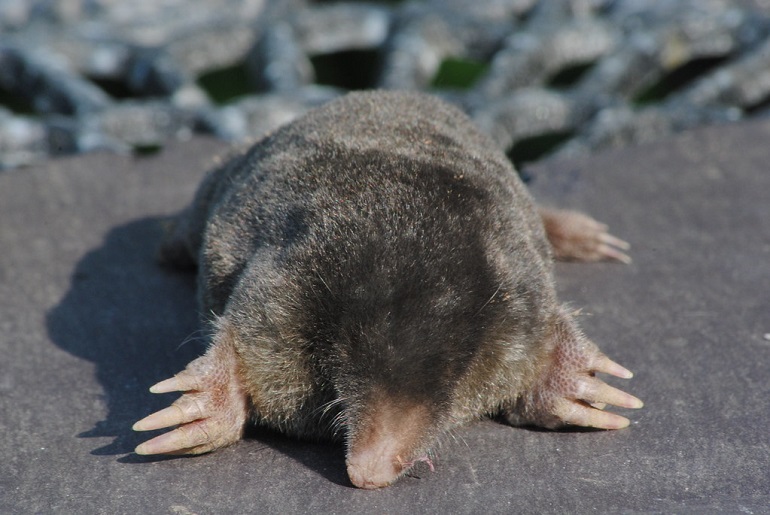
Most animals lack thumbs, which we regard as a mostly human trait. Some animal species that possess thumbs include koalas, apes, chameleons, lemurs, giant pandas, and moles.
Unlike the five-digit structure of hands with thumbs that we’re accustomed to, moles have an additional thumb called the prepollex. It’s conveniently located beside their thumb, giving this animal six digits.
However, the prepollex isn’t as well-developed as the other digits on a mole’s forepaws. It grows only one bone in the shape of a sickle and lacks multiple joints.
That’s because the pre pollex doesn’t develop at the same time as a mole’s other fingers, and its additional thumb branches off a wrist bone, similar to how giant pandas end up with thumbs.
Only moles have the additional thumb. Shrews, a close relative of the mole, do not.
Underground Breathing
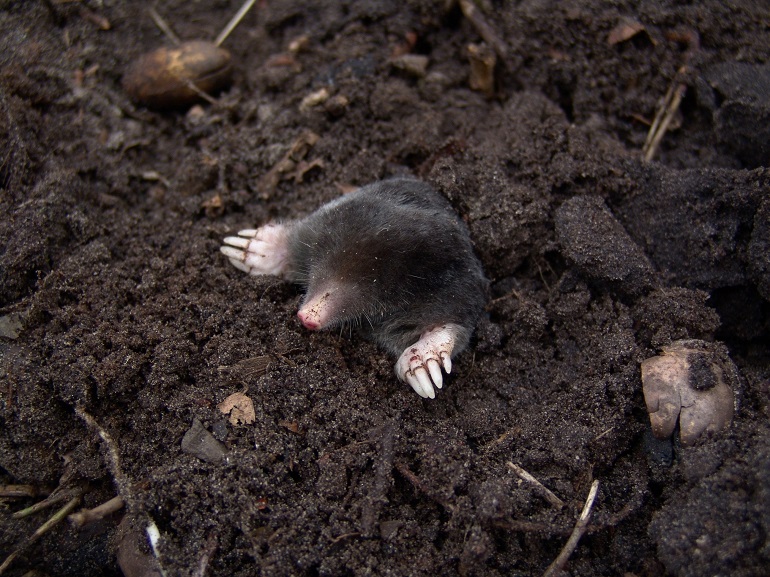
For an animal that spends most of its life in tight underground burrows, you might wonder how a mole could breathe. It all comes down to adaptation through evolution.
In their blood cells, moles possess a super hemoglobin form that allows the creature to reuse the air it breathes out. Moles also don’t mind greater carbon dioxide concentrations than other mammals.
Mole Appearance and Behavior
With so many moles, such as the Star-nosed mole, Blind mole, European mole, and Eastern mole, what one imagines when picturing a mole varies.
Let’s first go over the description of mole species and then look at how these creatures behave.
Mole Appearance
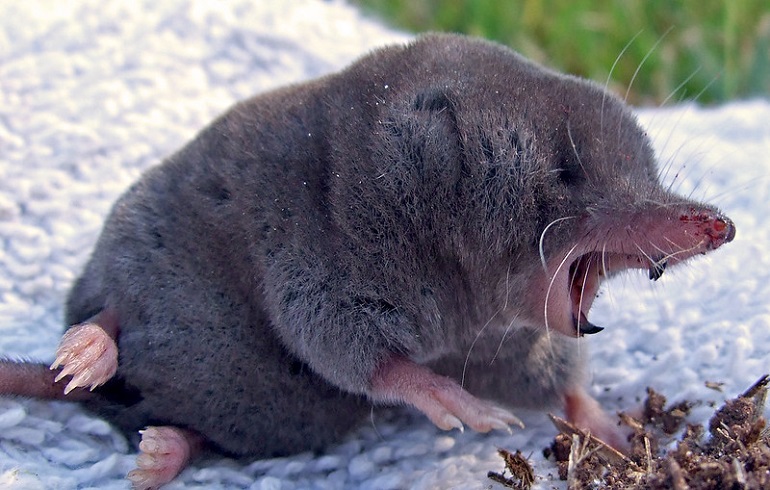
Most moles aren’t sizable animals, measuring between four and seven inches long. Their rear feet have a paddle-like shape to aid them in digging deep underground burrows, but most people pay more attention to their front paws.
The paws have long, blade-like claws. While the claws look like a defensive mechanism, these burrowing mammals use their claws primarily to ply through and move soil to create their burrows deep under the ground.
Moles have ears, but they’re internal rather than external. Some species, like the Golden mole, have sizable ossicles in their middle ears that scientists believe can help the animal pick up on vibrations in the ground.
The reason for internal ears is to prevent dirt from getting in them.
That may also explain why moles have small eyes, as larger eyes would invite dirt. Moles don’t have the greatest vision. Their eyes can detect light but don’t come in handy for much else.
The protruding pink snout of moles is especially long compared to the rest of its facial features, as is the mole’s head.
Besides the pink nose and the claws, moles are covered from head to toe in soft velvety fur. The most common fur colors include gray, brown, black, or a combination.
Mole fur isn’t smooth, so that you can pet it. Rather, it’s to improve the mole’s aerodynamics so the animal can easily slip through a tight tunnel backward or forward as required.
Mole Behavior

All parts of a mole’s body can help the creature dig, from its long body to its broadly-shaped forelimbs and long claws. That’s what moles do the most and what they excel at.
Moles will spend most of their time underground in the burrows and tunnels they dig but may resurface. They mark their burrows with urine having odorous substances produced by scent glands.
The animal’s behavior isn’t nocturnal, which means the mole would stay active during the day and sleep at night.
Instead, they’re crepuscular. Moles appear most active during the twilight hours. This, too, prevents them from becoming a predator’s next meal. In low visibility, such as during twilight, it’s much harder to spot a mole.
Once a mole has established a home, the creature spends much of its life alone. Moles will mate but are largely considered solitary animals.
Moles can become aggressive if you threaten their burrows!
Mole Scientific Classification
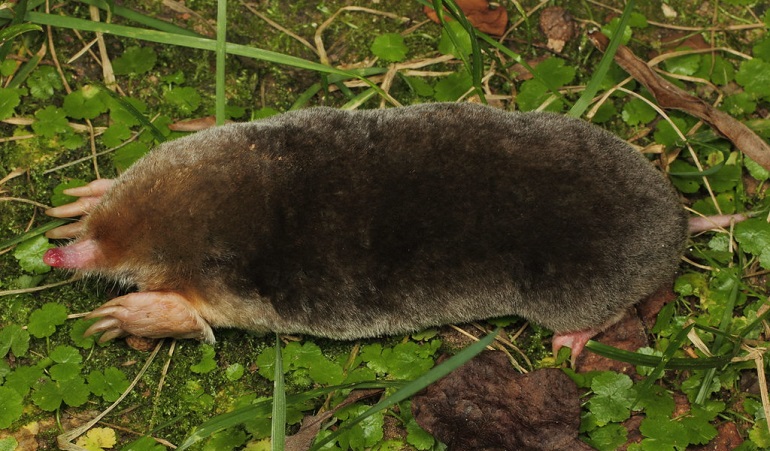
Moles primarily belong to the Talpidae family, with talpids being digging animals like moles, shrews, and the aquatic desman.
The various mole species are grouped into different subfamilies as follows.
Asian Shrew Moles – Uropsilinae
Although a name like the Asian shrew mole makes it confusing, this creature is indeed still a mole. It belongs to a sub-family of shrew-like moles native to Vietnam, Myanmar, and China’s forested regions.
New World Moles – Scalopinae
Moles in the Scalopinae family are primarily New World moles.
Old World Moles – Talpinae
This mole family consists mainly of Old World moles.
Classification by Tribe and Genus
You can also classify these burrowing mammals by tribe and genus. For example, the subfamily Uropsilinae consists of the Uropsilus genus with five species of mole.
The Talpinae subfamily has the following tribe and genus breakdown:
- Tribe Neurotrichini with the Neurotrichus genus, which includes American shrew mole from southwest British Columbia and the United States Pacific Northwest
- Tribe Urotrichini with the Urotrichus genus that includes Japanese shrew moles and the Dymecodon genus with True moles
- Tribe Scaptonychini with the Scaptonyx genus that includes long-tailed mole from Myanmar and China
- Tribe Talpini with the Talpa genus, Scaptochirus genus (short-faced moles), Parascaptor genus (southern Asia’s white-tailed mole), Mogera genus, and Euroscapter genus
- Tribe Desmanini with the Galemys genus that includes the Pyrenean desman and the Desmana genus with the Russian desman
The Scalopinae subfamily includes the following tribe and genus breakdown:
- Tribe Scalopini (New World moles) with the Scapanus genus (Western North American moles), Scapanulus genus (Chinese Ganus mole), Scalopus genus (North American Eastern mole), Parascalops genus (northeastern North America hairy-tailed mole), and Alpiscaptulus genus (Chinese Medog mole)
- Tribe Condylurini (North American star-nosed mole) with the Condylura genus, which includes the star-nosed mole animal
Mole Mating and Reproduction
The mole mating season may begin as early as January but is typically in February; this can vary by species. Moles will mate until May.
To find a female to reproduce with, male moles will dig tunnels in areas they’ve never been, squealing in a high pitch to alert female moles to their presence.
When male moles find a female, they’ll mate. It takes a female mole only four to six weeks of gestation to give birth. That means most young moles are born between March and April.
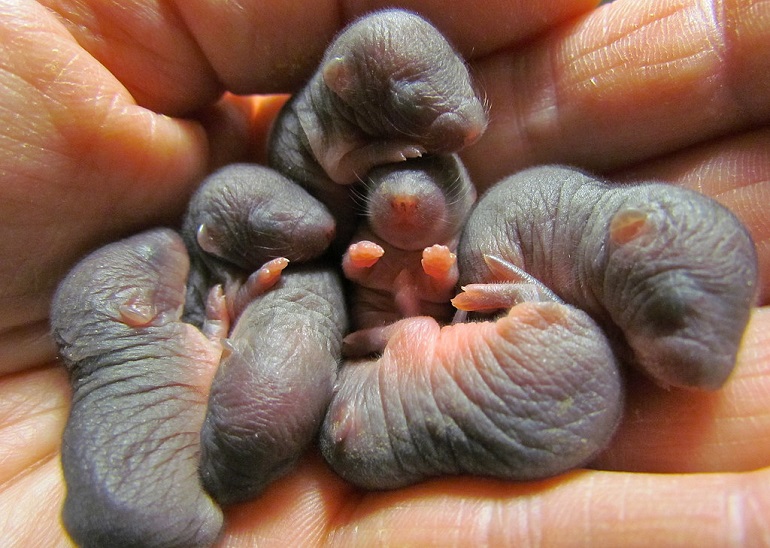
The average litter size of a female mole is two to five pups in a breeding season.
The pups live with their mothers for about a month and sometimes up to 36 days. Then they’re released to fend for themselves and forge territories. The young pups enter a period of sexual maturity about a year after birth.
While they’re finding their territories, young moles tend to leave the burrow at night. However, coyotes and owls usually pick them off.
Mole Habitat
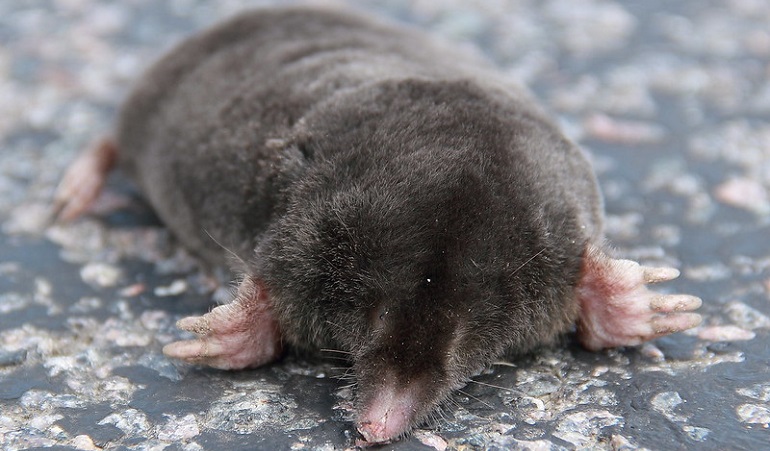
Moles live in various habitats, including riparian, wetland, desert, woodland, grassland, and meadow environments. They can make their home in sand dunes, gardens, urban areas, and grasslands.
Moles only need accessible soil to dig through to create burrows, so they’re not as picky about their environment as one would think. They prefer forests and fields for soft, pliable dirt, especially.
Mole Diet
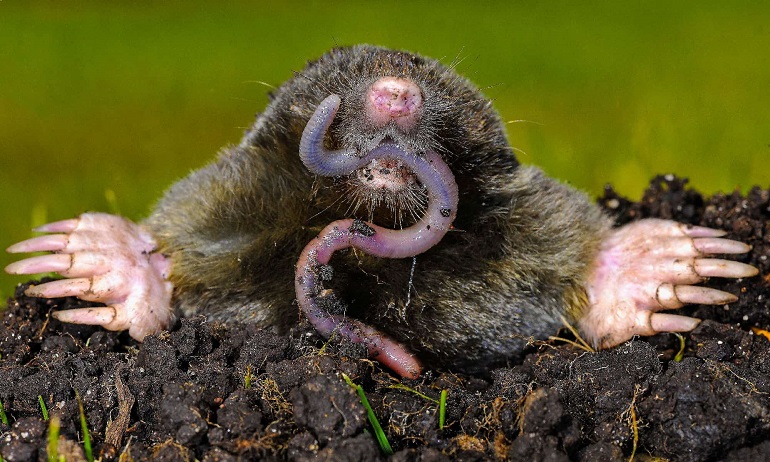
Sometimes classified as insectivores, moles are actually omnivores. Moles eat plant matter, smaller creatures, and other small invertebrates. They’ll dig through the soil and munch on the invertebrates they find along the way, but earthworms are a mole favorite.
The mole tunnels are worm traps; when a worm enters the tunnel, the mole will quickly strike, killing the worm on sight. Then they devour it.
It’s not always necessary for a mole to kill earthworms for consumption. Moles can paralyze earthworms stored in their mouths due to a toxin in the mole’s saliva, so they can hold the worms, burrow elsewhere, and then eat for energy.
Moles also have the option to store earthworms in larders, a homemade cupboard that, depending on its size, can keep hundreds to thousands of worms.
Lifespan
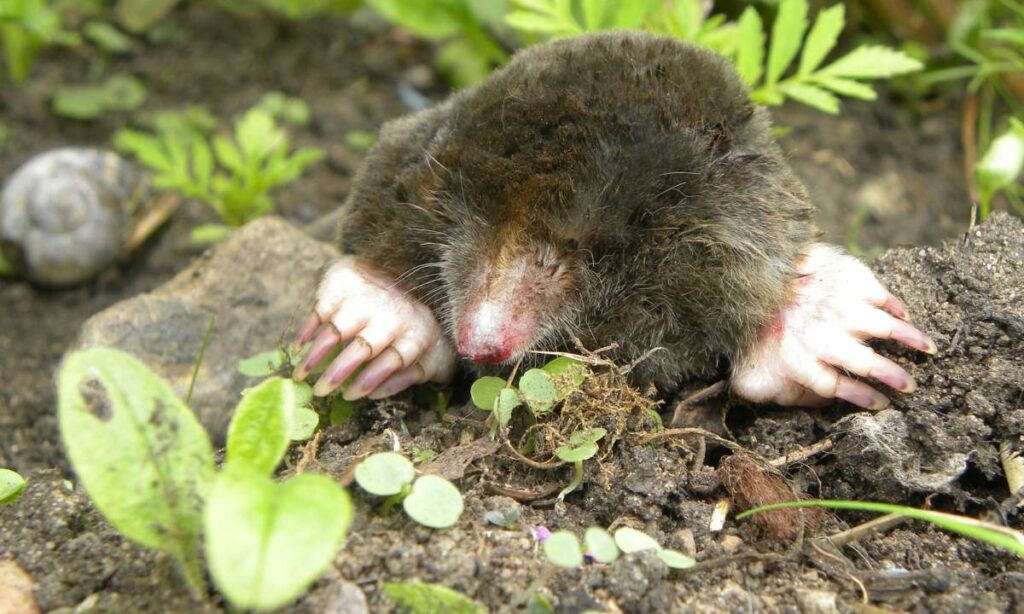
Moles have a typical lifespan of three to six years. Most moles will live for three years, but some can survive twice that.
Predators of Moles
Moles mostly die at the hands of predators. Here’s an overview of the creatures that prey on moles.
Humans
Most humans don’t intentionally set out to kill moles like they would when hunting for sport or fun. Rather, to preserve their gardens, humans will use chemical treatments that can kill moles when exposed.
Dogs
Stray dogs in a neighborhood will look for any food sources available, including moles.
Cats
Most cat species outsize moles, so stray cats looking for a meal don’t always pick from the trashcans. If they see a mole outside of its burrow, the fast reflexes of a cat can render it the winner in that battle.
Stoats
The ermine or stoat lives in some parts of North America, so it shares a habitat with the mole. Stoats make their homes in nests or underground tunnels, but they themselves do not dig. Instead, they’ll invade a mole’s burrow and kill them for mole tunnels.
Buzzards
The poor eyesight of a mole means the mammal might not see a buzzard coming until it’s too late. Buzzards may share similar hours to a mole, so if a mole ventures outside its burrow, it’s in trouble.
Owls
Owls are known for being nocturnal, but not all! Some are crepuscular, so buzzards and owls alike can pick off moles that leave the burrow.
Coyotes
Coyotes will prey on smaller creatures such as squirrels and marmots, so a mole isn’t outside their standard dietary choices.
Golden Moles and Marsupial Moles
In this section, let’s spotlight two mole species, the golden and marsupial moles.
Golden Moles

Beginning with the golden mole, this Sub-Saharan African mammal belongs to the Chrysochloridae family, which means it’s classified differently than Talpidae family moles.
Golden moles include 21 species in all, with most quite common but some rare and a few even endangered.
The golden mole features claws, stubby legs, dirt-repellent fur, and fur-covered eye that don’t work particularly well. They also have external ears and measure about 3.1 inches long.
Most live underground in meadows, deserts, forests, or leafy environments, but some will spend time above the surface. That’s the case for Grant’s golden mole, which cannot dig burrows in the Namib desert since the burrows will collapse.
Rather than live totally out in the open, Grant’s golden moles will dig into the loose sand and swim across it. This allows them to take shelter during the day, which can get unbearably hot.
By night, Grant’s golden mole will once again venture out to the surface to forage.
This species of the golden mole is the exception, not the rule. Others burrow just as much as other mole classes.
When golden mole species procreate, female moles may birth litters of one to three pups. They don’t breed at any specific time of the year but throughout the year as needed.
This mole is also quite territorial about its burrows and likes its space.
Marsupial Moles
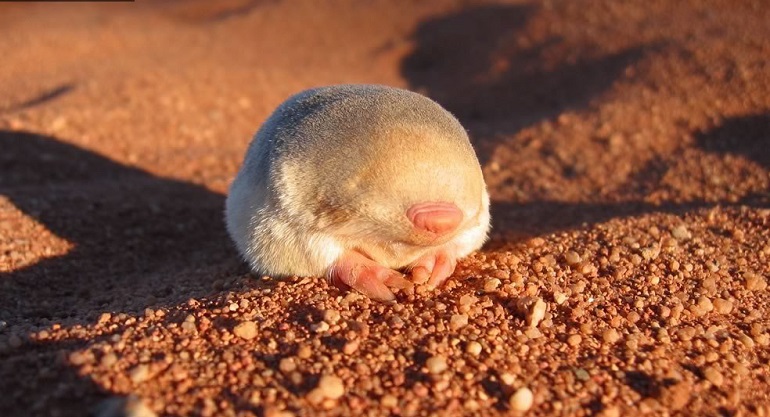
The marsupial mole in Australia belongs to the Notoryctidae family. They’re primarily underground-dwelling animals that only rise to the surface of their burrows when rains pass.
They are essentially blind, as their eyes lack pupils and have a skin covering. Like the golden mole, the marsupial also has very small ears.
Their long bodies, short tails, conical heads, and leathery outer skin enable the marsupial mole to navigate burrows.
A moderately big mole, marsupials measure up to 6.3 inches long and can weigh 2.1 ounces.
Mole Importance in Ecosystem
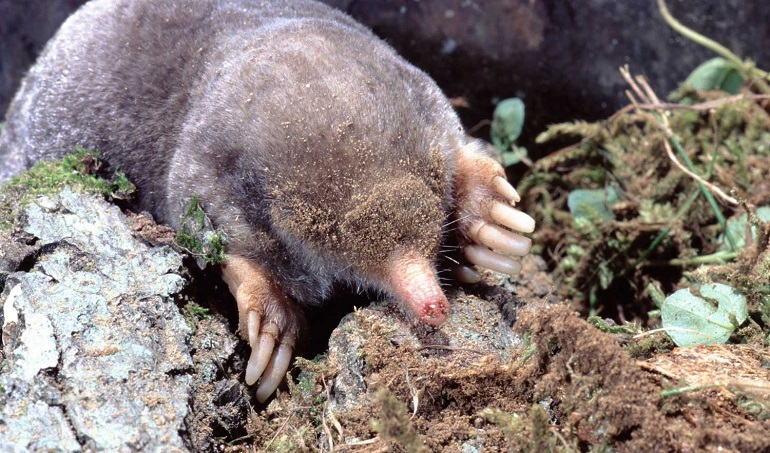
Although some perceive moles as a nuisance, they’re very important to the ecosystems they live in.
Moles can remove insects that many perceive as undesirable, as those are the primary diet of these creatures.
Even if a mole digs around your outdoor garden, you shouldn’t complain. A mole’s tunneling behavior will enable sod drying and promote better soil aeration.
Organic matter can also reach deeper into the soil since the moles kicked it up!
Interaction with Humans
As solitary creatures, moles don’t interact much with humans. You’ll recall that humans are potential predators of moles, which gives the mammal another reason to stay far away from people.
Moles don’t make good pets because they don’t live long. It’s also difficult to provide the optimal conditions a mole needs (i.e., an underground moles burrow) in a household environment.
Additionally, moles can spread diseases such as rabies, so humans should give moles a wide berth.
Conservation Status
Mole conservation is not a chief concern, which is saddening considering that some species have become rare and others endangered.
The endangered moles include:
- Lesser blind mole-rat
- Somali garden mole
- Star-nosed mole
- Mehely’s blind mole-rat
- Oltenia blind mole-rat
- Cape mole-rat
- Northern marsupial mole
- Bukovina blind mole-rat
- Gunning’s golden mole
- Southern marsupial mole
- Rough-haired golden mole
- Townsend’s mole
- Van Zyl’s golden mole
- Giant blind mole-rat
- Mole skink
- Giant golden mole
- Eastern mole
- Juliana’s golden mole
- Cape golden mole
- De Winton’s golden mole
What threatens these and other moles? Outside predation, mining is the biggest threat to moles, especially golden ones.
Mole Facts
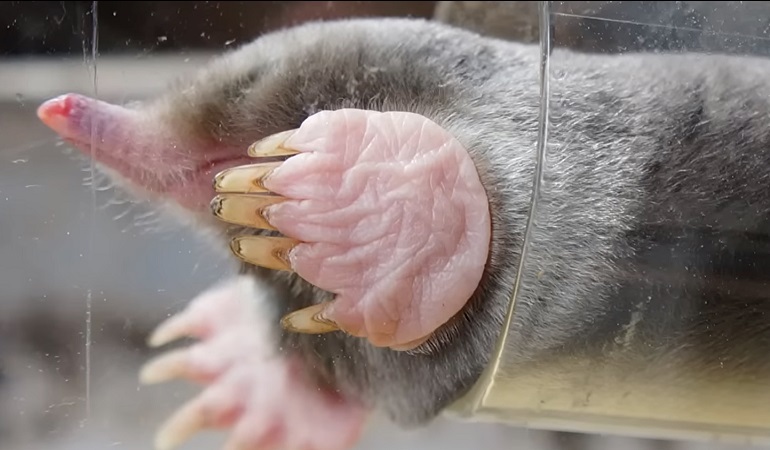
Here are some interesting mole facts for you.
- Star-nosed moles are incredibly speedy eaters, tracking and consuming prey far faster than humans can track with the naked eye.
- Townsend moles breed earlier than most mole species, mating in February or March. Pregnant females will gestate for about 30 days and then bear two to four pups in March or April.
- Moles don’t blindly consume earthworms. Instead, they run the worms through their paws to remove as much dirt from the worm as possible.
- Moles move through the dirt in their burrows at speeds of up to four miles per hour to catch worms or escape enemies.
- A star-nosed mole’s facial star is incredibly sensitive, far more so than any other mammal’s touch organ.
FAQs
Are Moles Blind?
All moles have eyes, and even the ones with the word “blind” in the species name can see. At their most basic, moles use their eyes to detect light. Since the animals are nearsighted and colorblind, their vision doesn’t come in handy for much else.
Are Moles Dangerous?
Moles can pose a danger when they feel like a predator is invading their burrow. They become staunchly defensive, then. Moles also spread diseases, so they’re dangerous in plenty of ways.
What’s the Difference Between Moles and Mice?
Moles and mice diverge quite a lot! Moles lack tails, whereas mice have long, skinny, pink tails.
Mice have visible eyes with better vision than moles, although their vision still isn’t great. Further, mice are smaller, have different fur colors, and don’t exclusively live in burrows. They can also reside in nests.
What’s the Difference Between Moles and Shrews?
Moles and shrews are closely related and may resemble a bit, but they are still not identical.
Shrews only measure four or five inches long, making them smaller. They don’t traditionally dig their own tunnels but use existing tunnels, and shrews will also feed aboveground.
How Deep do Moles Dig?
Traditionally, a mole’s surface tunnel extends three to 12 inches underground, but if a mole wants to create a deep burrow, it will go as much as 40 inches deep.
Conclusion
Moles are burrowing creatures people perceive as pests because they move the dirt around in outdoor gardens and landscaping.
While human and mole interactivity should remain at a minimum, moles are usually just trying to take shelter and find food, so pay their burrows no mind!












